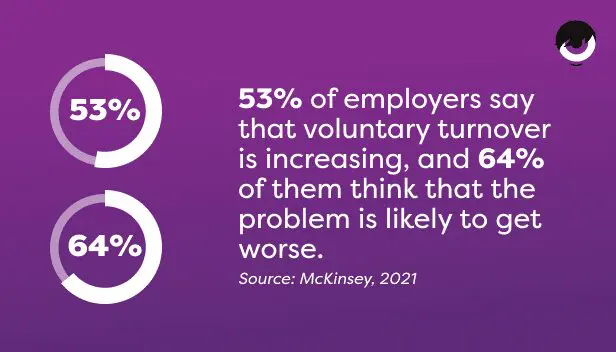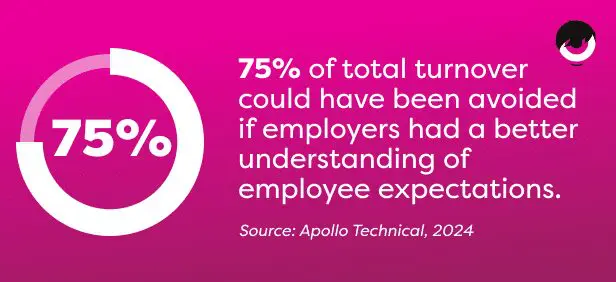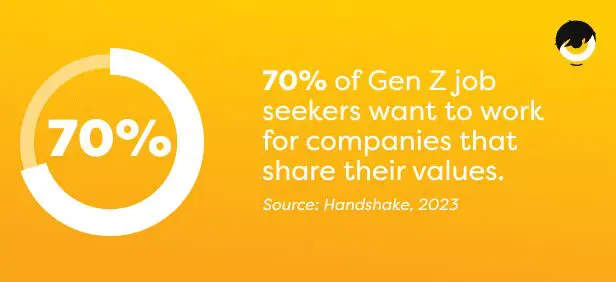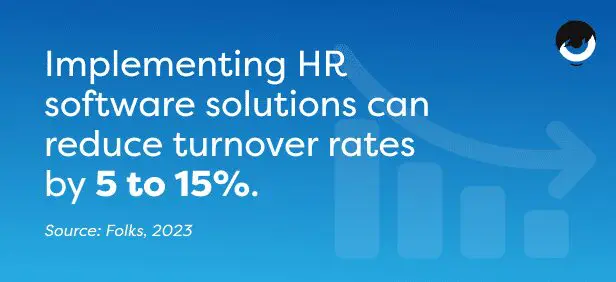Although the Great Resignation has fizzled out in most industries, employee turnover remains high in many organizations. Over half of worldwide businesses currently struggle with employee retention.
Considering the costs of recruiting and onboarding processes and the loss of skills and expertise associated with high turnover rates, it is crucial to focus on engagement strategies and key statistics that showcase the state of retention in companies. Here is everything you need to know about employee retention and tips to increase retention rates in your organization.
What is employee retention – and why does it matter?
Employee retention refers to an organization’s ability to retain workers over time. Employee retention rates can be calculated by dividing the number of existing employees on the last day of a period by the number of employees on the first day.
Poor retention rates indicate motivation and management issues in the workplace, which are likely to negatively impact business growth. Companies that reduce turnover costs and succeed in retaining high-performing employees can experience a potential fourfold increase in profits. It makes sense that all organizations would benefit from highly engaged employees who are willing to stay with them in the long run, and as such, retention efforts are often at the forefront of HR strategies.
However, there is a disconnect between what employers think employees want – and what employees truly want. Without further ado, here are the key retention statistics you need to know to guide your efforts.
The State of Employee Retention
First and foremost, it is important to get a global perspective on the state of employee retention in recent years. Here are important numbers you need to know:
Turnover rates in Canada have increased to 15.5% in 2023. (Mercer, 2023)
In 2022, they amounted to 12.4%. There seems to be a new trend of turnover rates increasing every year without fail, which means that action needs to be taken sooner rather than later!
Since 2010, turnover rates have increased by a staggering 88%. (WorkInstitute, 2020)
As previously mentioned, turnover has been exponentially increasing in the past decade. This means that employee expectations have changed and that their employers have failed to meet or understand them.
Of course, this statistic could also highlight the fact that newer generations of workers are less likely to spend their entire professional lives in the same company. There are definitely several factors at play here, and we’ll dive into these aspects later on in this article!
53% of employers say that voluntary turnover is increasing, and 64% of them think that the problem is likely to get worse. (McKinsey, 2021)
As you can see, most employers are not optimistic about the future state of employee retention, as they are noticing ever increasing turnover rates and struggle to stem the tide of employee departures.

87% of HR managers say that retention is a priority in their organization. (Bonusly, 2022)
Despite these turnover issues, a vast majority of HR managers are ready to make retention strategies a top priority in their organization. This statistic makes sense, as most HR strategies focus on improving the work environment and are at least in part linked with an effort to motivate and retain talented employees.
80% of employees are at least somewhat disengaged at work. (Gallup, 2022)
Disengagement spans across many levels. Some employees are not actively engaged, others are completely disengaged. In any case, this statistic is alarming and showcases the importance of focusing on retention efforts in your company.
40% of employees say they are considering the possibility of quitting their jobs in the next few months. (McKinsey, 2021)
Of course, disengaged employees are most likely to leave your company or at least pursue opportunities elsewhere. Salary is simply no longer enough to ensure that your teams are happy and productive and will stay with you in the long run.
46% of high performing employees are actively browsing job search apps. (Bonusly, 2022)
High performing employees are more inclined to search for other job opportunities, as they know that their skills can be coveted and appreciated by other employers. If they feel like they could get better work conditions, benefits and recognition elsewhere, it makes perfect sense that they would be on the lookout for opportunities on job search apps.
36% of employees who quit do so without having another job lined up. (McKinsey, 2021)
This statistic shows a shift from previous trends: a high number of workers are now comfortable with the idea of quitting without knowing what they are going to do next. This might be a sign of confidence in their own worth and skills or proof that they are ready to prioritize their well-being by leaving an organization where they are not thriving.
More than 50% of employees think they could find a better job with better pay. (CNBC, 2022)
If your employees know that they could get a better paid, more qualified role elsewhere, it might be time to promote them to a higher position or give them a well-deserved raise. You can also stand out from competitors by creating an unmatched work environment and corporate culture that will help you attract and retain talent.
75% of total turnover could have been avoided if employers had a better understanding of employee expectations. (ApolloTechnical, 2024)
Despite the previous information we shared, this statistic shows that turnover can be avoided if employers focus their efforts and energy on understanding employee expectations and act accordingly.

Main Factors Impacting Employee Retention
Now that we have general information on employee retention, it is time to identify the main factors that influence talent to leave your company – or stay in the long run.
20% of employees leave during their first 45 days of employment. (HarvardBusinessReview, 2018)
First impressions are crucial to ensure long-term retention: you only get one shot at showing the environment and culture you can offer to your new hire. Poor onboarding processes are often the root cause of early turnover.
Employers and managers who act on employee feedback are 4 times more likely to retain talent. (TeamStage, 2024)
Employees want to be heard and to shape their own work environment according to their expectations and values. Collecting employee feedback is a great first step, but you also need to create action plans based on the information and ideas that were shared.
44% of employees want to switch jobs because they don’t receive enough recognition. (VantageCircle, 2024)
If we said it once, we said it a hundred times: recognition should be at the forefront of your retention strategies. If high performing employees feel like their work is not appreciated, they will be more likely to search for other opportunities. Smaller contributions also need to be highlighted through recognition phrases, reward systems, and peer recognition.
66% of workers would start looking for a new job if remote work was no longer a possibility in their organization. (Bonusly, 2022)
In the past few years, workers have come to appreciate and expect flexible work conditions. Remote work has become an important part of many employees’ lives and has transformed the way we envision work-life balance and professional relationships. If you offer remote work possibilities while maintaining a cohesive corporate culture, you are more likely to attract talent and retain them.
Trust between employees and managers increases retention fivefold. (Gallup, 2022)
Remote work and recognition are not the only aspects to take into account when setting up retention strategies. Employees also need to know that their manager trusts them, and that they can trust them in turn. Micromanagement and excessive work tracking are stifling and lead to unhealthy and unproductive professional relationships.
Companies that don’t have engagement strategies in place risk losing 31% of their employees. (FlairHR, 2023)
Engagement strategies are crucial, and they need to be regularly updated and improved according to employee feedback to remain relevant and appreciated by your teams. Identify motivation issues, ask your employees what they think, and let your imagination and strategic streak do the rest!
51% of exiting employees have not discussed workplace satisfaction or career future for months prior to their departure. (Gallup, 2022)
Engagement surveys are essential to take the pulse of your organization and act on employee feedback. You can also set up stay interviews to get valuable insights on workplace satisfaction and identify individuals who are at risk of leaving or losing motivation.

Retention Statistics by Generations of Workers
Employee retention strategies can differ depending on the demographics that shape your workforce. Here are interesting stats you might want to consider in your retention efforts:
30% of millennials would quit if they received a better job offer. (IndustrialDistribution, 2016)
Although this statistic completely makes sense from a strategic viewpoint, it also underlines the fact that millennial employees are less likely to feel a sense of belonging in their companies and are often open to new opportunities.
All generations of workers say that job security is one of their top reasons for staying in a company. (CanadianHRReporter)
However, job security can only go so far: it also means that your employees are not necessarily staying because they feel like an integral part of your company or are highly engaged in their day-to-day work. If you have nothing else to offer to your teams, they can quickly lose motivation.
31% of Gen Z and millennial employees look for development opportunities when applying for jobs. (Deloitte, 2023)
Younger generations of workers are looking for opportunities to learn and grow alongside their new employer. If you fail to provide these avenues for improvement, they might quickly leave your organization – or even never apply to the open position in the first place.
64% of millennials would rather make less money working a job they love. (Inc.com, 2017)
These numbers are very interesting, as they prove that salary is definitely not the most important aspect of employee retention and motivation. Most millennial workers are more interested in finding happiness and a sense of accomplishment in their work than they care about their payslip.
Millennial turnover costs approximately $30.5 billion to companies. (Gallup, 2022)
Millennials are often called the “job-hopping generation” for a reason, as they are often looking for better opportunities and are less attached to their current companies than previous generations of workers were. They are definitely a demographic that needs particular attention when it comes to retention efforts in all organizations.
70% of Gen Z job seekers want to work for companies that share their values. (Handshake, 2023)
By 2025, Gen Z will represent a quarter of the global workforce, so it is definitely time to start implementing HR strategies that take their expectations into account. It is interesting to note that future Gen Z turnover might be caused by a lack of alignment in values.

75% of Gen Z workers would consider other opportunities if their current employer is not socially aware. (RippleMatch, 2022)
Gen Z workers want to work for employers who understand the current state of the world and are trying to make a positive impact where they can. Community engagement, social stances and ecological awareness are also important factors for younger generations of employees.
Strategies to Improve Retention Rates
Need advice on how to improve employee retention rates in your companies? Here are some numbers that can guide your action plans, with bonus tips and tricks:
“Healthy” annual turnover rates should be around 10%. Most companies have a turnover rate of approximately 20%. (SelectSoftwareReviews, 2024)
This statistic proves that a vast majority of companies need to improve their retention strategies to decrease turnover rates and make sure that they remain at healthy levels of attrition. All employers and HR departments should feel concerned by employee retention issues!
Effective well-being programs incite 89% of employee referrals. (Gallup, 2022)
Employee well-being programs are often underestimated and overlooked, although they encourage talent to recommend their companies to job seekers and improve talent attraction. As we have previously mentioned, salary is not the most important factor, and health benefits and well-being initiatives are a priority for a large number of workers.
Employees who benefit from effective onboarding programs are 69% more likely to stay 3 years in an organization. (MyShortLister, 2020)
It comes as no surprise that effective onboarding processes should be at the center of your retention strategy. We have a lot of helpful resources on employee onboarding on our blog, and we encourage you to take a look at our article on onboarding stats every employer should know to get useful tips and tricks!
Implementing HR software solutions can reduce turnover rates by 5 to 15%. (Folks, 2023)
The decrease in turnover rates is an integral part of the ROI of HR software solutions. Picture this: you are a newly hired employee in the onboarding phase of his career journey at their new company. When your first day comes, you realize that nothing is automatized, and that you will have to send multiple emails to complete the necessary administrative tasks, all the while discovering your new position and trying to digest a consequential wave of information.
This is only one example of how lack of technology tools can negatively impact employee satisfaction and, ultimately, long-term retention. HR digital transformation should definitely be at the top of your priority list in 2024.

For a company with a 120 headcount, this reduction in turnover rates translates into approximately $41 000 saved per year. (Folks, 2023)
On top of reduced turnover costs, implementing the right HR solutions mitigates loss of knowledge in your organization, ensures efficient business operations, and supports smooth transitions when your employees do leave the company.
Discover how HR technology can increase retention rates:
Implement a flexible HRIS to improve employee experience!

